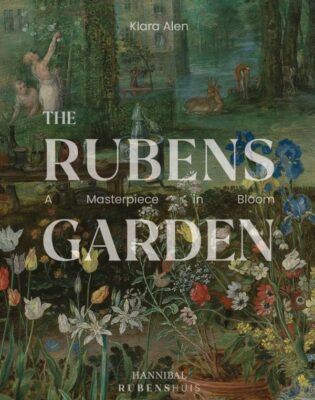This small book by Klara Alen, research curator of the historical garden of the Rubenshuis, was published in 2024 to mark the renovation and redesign of Rubens’s garden, located in the heart of Antwerp. A narrow plot, acquired by the painter in 1610, was transformed by him into an oasis that remains a peaceful retreat amidst the bustling business district of the city. We know little of the original design of this oasis by Rubens himself. He built a city palace there inspired by Italian models, which included a studio, residence, courtyard, pavilion, and an Italian-style portico through which one entered the garden. A fold-out map in the volume provides an overview of the redesigned layout which shows that the entrance has been relocated.The plants found in the garden since this year are catalogued alphabetically from A to T in the book: A Small Florilegium of the Rubens Garden. As we do not know what the specialists of the time, the gardeners Willem Donkers and Jaspar Verbruggen, actually planted, the current replanting relied on historical images and publications from that period and their nomenclature. Thus, A to T refers to the respective common Latin terminology alongside today’s popular names, such as “Aquilegia vulgaris” or common columbine, “Taxus baccata”, today’s yew, up to “Tulipa”, the tulip. Each plant is accompanied by a colored illustration, whether from historical sources or photographs of the plants found today. The accompanying detailed text provides easy-to-read information on botanical and cultural-historical aspects.
Unfortunately, Rubens, at least according to currently known sources, only once commented on the fruits growing in his little paradise, in a letter of August 17, 1638, sent from his country estate “Het Steen” to his young pupil and assistant, Lucas Faydherbe, who had stayed behind in the studio in Antwerp but was about to leave to join his master in the country: “Take good care, when you leave, that everything is well locked up, and that no originals remain upstairs in the studio, or any sketches. Also, remind Willem the gardener that he is to send us some Rosile pears [Pyrus Rousselet de Reims] as soon as they are ripe, and figs when there are some, or any other delicacy from the garden.”
Always careful, Rubens made sure that the studio, house, and garden were closed to uninvited guests and the curious. As regards the garden, this was not uncalled for. We know that tulip bulbs sometimes were stolen from other Antwerp gardens during the night.
The historical introduction at the beginning of the book contains much interesting information about Rubens’s sources of inspiration for his sophisticated architectural and garden concepts, such as the almost zoological, courtly garden at the residence of the Archdukes Albert and Isabella in Brussels, Rubens’s important patrons. Beyond the design of the garden and its planting, it informs us that the Rubens family kept a cat, presumably to combat the ever-present mice in house and garden. Furthermore, we learn that the highest-ranking servant was named Jan Drion, the kitchen maid Willemyne, and that the maids Anneken and Adriaenken could also be encountered in the garden. Even the earnings of the domestics are being discussed.
One of the drawbacks of this small volume is the lack of annotations, partly mitigated by a short bibliography. Beyond that, however, the book is a carefully researched and beautifully illustrated reconstruction of Rubens’s garden, offering especially those who do not have the time or leasure to visit Antwerp the opportunity to enjoy Rubens’s green oasis.
Ursula Härting
Hamm (Germany)
